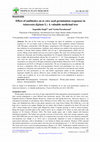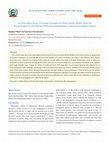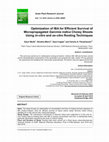Papers by Varsha Parasharami
Curr. Sci, 2003
... Varsha A. Parasharami, Insiya S. Poonawala and Rajani S. Nadgauda* Tissue Culture Pilot Plant... more ... Varsha A. Parasharami, Insiya S. Poonawala and Rajani S. Nadgauda* Tissue Culture Pilot Plant, National Chemical Laboratory, Dr Homi Bhabha Road, Pune ... 2b) consisting of dormant buds at the axil of each needle, shoots with fully grown needles and with brown scales at ...
Plant Cell Tissue and Organ Culture, 1997
Seedling explants of Bambusa arundinacea were cultured in a Murashige & Skoog (MS) based liquid m... more Seedling explants of Bambusa arundinacea were cultured in a Murashige & Skoog (MS) based liquid medium, supplemented with sucrose (2), coconut water (5) and 6-benzylaminopurine (2.2 μM). In 3–6 months about 70 of the cultures flowered. A comparison was made between in vitro and in vivo flowering. Though smaller in size, in vitro florets were morphologically comparable to the in
In Vitro Cellular & Developmental Biology - Plant, 1993
Proliferation of terminal and axillary buds of 20 yr-old Pinus caribaea and P. kesiya trees was o... more Proliferation of terminal and axillary buds of 20 yr-old Pinus caribaea and P. kesiya trees was obtained on half strength DCR medium supplemented with 0.5 mg. liter-1 6-benzylaminopurine (BA). These sprouts further elongated with the formation of multiple shoots with the ratio of 1:3, on transfer to medium in which the 0.25 mg. liter-1 BA of the initiation medium was replaced by 0.25 mg. liter-1 kinetin. Rooting was obtained on the same medium. Plantlets thus formed were transferred to perlite:peat:vermiculite mixture (1:1:1) in polybags (10 X 5 cm) under 80 +_ 5% humidity in a polyhouse.

Adansonia digitata L. is a native deciduous tree of African savannas and belongs to the family Bo... more Adansonia digitata L. is a native deciduous tree of African savannas and belongs to the family Bombacaceae. The tree faces a crisis of survival and is enlisted as an endangered species in the Red Data book. Currently, fear has been expressed about its regeneration. Adansonia has immense medicinal value and possesses various pharmacological properties like anti-bacterial, anti-fungal, anti-malarial, anti-pyretic and almost all parts of the tree are used for healing purposes. To explore its pharmacological uses and isolation of bioactive compounds, phytochemical screening of in vivo and in vitro parts was carried out in Acetone, Methanol and Aqueous solvents. Results indicate the presence of phytochemicals like Alkaloids, Flavonoids, Saponins, Terpenoids and Tannins in almost all extracts. Fatty acid content was highest in methanol fruit pulp. Presence of phytochemicals may further contribute to anti-microbial activity and isolation of bioactive compounds using cell and suspension cul...

Constant variation in climatic conditions and limitations regarding resource availability in fiel... more Constant variation in climatic conditions and limitations regarding resource availability in field conditions makes plants an ideal system to be used as biofactories for constant production of variety of chemically and therapeutically important compounds. The alarming rate at which diabetes is spreading can only be estimated by WHO’s annual report which state that by the end of 2030 approximately 360 million people will be suffering from this deadly disorder. Taking the note of these recent developments there is an urgent requirement to develop a low-calorie sweetening source which can be natural, safe, and alternative to sugar and other artificial sweetening agent with an efficacious and sound economic approach. The plant Stevia rebaudiana (Bertoni) (Family Asteraceae) is a source of low-calorie sweeteners. The leaves of S. rebaudiana are main reservoir of the sweet glycosides which contain more than 30 steviol glycosides amongst which stevioside and rebaudioside A, are reported to...
Agrobacterium rhizogenes mediated transformation system was found to be very useful in metabolic ... more Agrobacterium rhizogenes mediated transformation system was found to be very useful in metabolic engineering (Hamill and Lidgett, 1997; Rao and Ravishankar, 2002), genetic manipulation of plants for the production of phytochemicals such as enzymatic pathways, key intermediates and critical regulation points and production of transgenic herbals (Fu et al., 2006; Piatczak et al., 2006; Shanks and Morgan, 1999), large scale secondary metabolite production (Choi et al., 2000), monoclonal antibody production (Wongsamuth and Doran, 1997) and phytoremediation (Nedelkoska et al., 2000). There are many reports that suggest the successful use of A.rhizogenes harbouring binary vectors with desired gene construct (Christey, ISSN: 2319-7706 Volume 3 Number 6 (2014) pp. 720-730 http://www.ijcmas.com

A B S T R A C T Ficus religiosa L., commonly known as Peepal tree is a medicinally important tree... more A B S T R A C T Ficus religiosa L., commonly known as Peepal tree is a medicinally important tree species belonging to the Moraceae family. It is considered a sacred tree in India and is respected by followers of many religions. It is extremely popular in indigenous system of medicine like Ayurveda, Siddha, Unani and Homeopathy. Studies have been carried out in the past that validate the antimicrobial property of Ficus religiosa and have been documented. Recent pharmacological reports show the potential of this tree as a source of many bio medicinally active compounds/molecules that could be used for future drug synthesis. These reports have focused on investigating the antidiabetic, anticancer, antiulcer, anticon vulsant, antioxidant, nootropic and wound healing properties of different parts of Ficus religiosa. While working on antimicrobial property studies with different solvent extracts of various parts of this tree, recent research articles have been surveyed. Most of the recen...

The Chrysanthemum genus belongs to the genus Asteraceae which covers up to 15% of all the species... more The Chrysanthemum genus belongs to the genus Asteraceae which covers up to 15% of all the species of this genus. The natural insecticidal compound pyrethrin is found in C. cinerariaefolium and mostly found in the aerial parts such as achenes of the flowers. Chemically pyrethrin is a set of six structurally close monoterpene esters formed by esterification of two monoterpenic acids (chrysanthemic acid and pyrethric acid) with three ketone alcohols (pyrethrolone, cinerolone and jasmolone). The side effects of the chemical analogue of this molecule and eco-friendly action of pyrethrin such as rapid degradation into the environment and swift action against insects make this molecule the ultimate choice for scale-up industries thus far making this plant system of uttermost importance which needs biotechnological intervention. The in vitro research in this plant system is not completely achieved as the whole pathway-level understanding is not fully understood. Apart from it, the regenerat...

Physiology and Molecular Biology of Plants
The present study was carried out to silence the transcription factor genes ZCT1, ZCT2 and ZCT3 v... more The present study was carried out to silence the transcription factor genes ZCT1, ZCT2 and ZCT3 via lipofectamine based antisense LNA GapmeRs transfection into the protoplasts of established photomixotrophic cell suspensions. The photomixotrophic cell suspensions with a threshold of 0.5% sucrose were raised and established using two-tiered CO2 providing flasks kept under high light intensity. The photomixotrophic cell suspensions showed morphologically different thick-walled cells under scanning electron microscopic analysis in comparison to the simple thin-walled parenchymatous control cell suspensions. The LC-MS analysis registered the vindoline production (0.0004 ± 0.0001 mg/g dry wt.) in photomixotrophic cell suspensions which was found to be absent in control cell suspensions. The protoplasts were isolated from the photomixotrophic cell suspensions and subjected to antisense LNA GapmeRs silencing. Three lines, viz. Z1A, Z2C and Z3G were obtained where complete silencing of ZCT1, ZCT2 and ZCT3 genes, respectively, was observed. The Z3G line was found to show maximum production of vindoline (0.038 ± 0.001 mg/g dry wt.), catharanthine (0.165 ± 0.008 mg/g dry wt.) and vinblastine (0.0036 ± 0.0003 mg/g dry wt.). This was supported by the multifold increment in the gene expression of TDC, SLS, STR, SGD, d4h, dat, CrT16H and Crprx. The present work indicates the master regulation of ZCT3 knockdown among all three ZCTs transcription factors in C. roseus to enhance the terpenoid indole alkaloids production. The successful silencing of transcription repressor genes has been achieved in C. roseus plant system by using photomixotrophic cell cultures through GapmeR based silencing. The present study is a step towards metabolic engineering of the TIAs pathway using protoplast transformation in C. roseus. Supplementary Information The online version contains supplementary material available at 10.1007/s12298-021-01017-y.
Industrial Crops and Products
Plant Cell, Tissue and Organ Culture (PCTOC)

Tropical Plant Research
The aim of this work was to investigate the effect of Antibiotics on germination responses in vit... more The aim of this work was to investigate the effect of Antibiotics on germination responses in vitro on mature seeds of Adansonia digitata. Three antibiotics namely Cefotaxime (100-500 ppm), carbenicillen (100-500 ppm), streptomycin (100-500 ppm) were tried to assess their influence on seed germination. Antibiotic stock solutions were added to the autoclaved basal medium ½ Woody Plant medium (WPM) with 0.8 mg l-1 Benzylaminopurine (BAP) and 4% sucrose. Mature seeds without seed coat were used as explant. The seeds were sterilized using 70% ethanol for 30seconds and 4%sodium hypochlorite for 10 minutes followed by incubation for 30 days in light with photosynthetic photon flux of 6 μmol m-2 s-1. 16 / 8 hour photoperiod. 30 seeds were used for each treatment and the experiment was repeated thrice. 76.6% germination (maximum) was observed in 300 ppm cefataxime treated medium followed by 44.4% at 300 ppm streptomycin and 56.6% at 300 ppm of carbenicillen. The use of streptomycin as an antibiotic did not have a stimulatory effect on seed germination. Percent seed germination was very less as compared to cefataxime and carbenicillen. The study was carried out to develop the most suitable protocol for seed germination in vitro and further regeneration studies on this aesthetically important valuable tree species. However, more variables like the effect of Photoperiod, culture vessels, age of explant etc. on in vitro seed germination have to be standardized to generate a complete protocol.

Acta Scientific Agriculture
The current study aims to micropropagate female cultures of Garcinia indica Choisy ('Kokum') and ... more The current study aims to micropropagate female cultures of Garcinia indica Choisy ('Kokum') and hence, focuses on improvising sterilization techniques for ensuring high survival of the explants of G. indica; an endemic tree species of the Western Ghats. Kokum shoot buds were collected from fruiting mother trees across nine different locations in Konkan, Maharashtra, India. G. indica is a proliferent producer of phenols and polyphenols and is also prone to certain endogenous contamination. Treatment of the explants with sterile distilled water, Tweens 20, 10%(v/v) savlon and 0.1% PVP along with 1% anti-fungal agent bavistin followed by an aseptic treatment with 0.75%HgCl 2 and drying of shoots for 60minutes before inoculations resulted in 87% survival of healthy, sterile buds. Of the nine locations, donor plants growing naturally from the villages of Sarole, plantations in Panose-Koste, and the grafted varieties of Hatis and Amruta from Balasaheb Deshmukh Krishi Vidyapeeth, Dapoli gave an average sprouting of 24.66%. The present study is the first of its kind to publish a detailed location-wise collection of G. indica mother shoots and standardize a sterilization protocol for clonal propagation of G. indica female plants.

Asian Plant Research Journal
Aims: The study focuses on optimization of concentration and time of rooting hormone exposure of ... more Aims: The study focuses on optimization of concentration and time of rooting hormone exposure of IBA (Indole-3-Butyric Acid) for efficient survival of tissue culture raised Garcinia indica Choisy plantlets for in-vitro and ex-vitro rooting techniques. Study Design: The subcultured microshoots of Garcinia indica were subjected to in-vitro and ex-vitro rooting trials by treating them with IBA of varying concentration and time, to standardize these particular parameters required by this auxin to induce rooting. Place and Duration of Study: Rooting trials were carried out in Plant tissue culture-Biochemical Sciences Division of CSIR- National Chemical Laboratory, Pune 411008 between June 2018 and April 2019. Methodology: Regularly subcultured five to six years old shoots from female trees of Garcinia indica were used for the study. Various concentrations of IBA in correlation with time were used for in-vitro and ex-vitro root induction. The rooted plantlets were then transferred to poly...
Industrial Crops and Products
Uploads
Papers by Varsha Parasharami